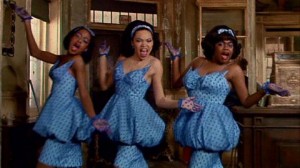100 Film Favorites – #60: Little Shop of Horrors
(Frank Oz, 1986)
 “On the 21st day of the month of September, in an early year of a decade not too long before our own, the human race suddenly encountered a deadly threat to its very existence. And this terrifying enemy surfaced, as such enemies often do, in the seemingly most innocent and unlikely of places…”
“On the 21st day of the month of September, in an early year of a decade not too long before our own, the human race suddenly encountered a deadly threat to its very existence. And this terrifying enemy surfaced, as such enemies often do, in the seemingly most innocent and unlikely of places…”
Little Shop of Horrors is probably the best movie based on a Broadway musical based on another movie…though I guess it might have some competition for that honor with the Matthew Broderick version of The Producers. At any rate, let’s agree that Little Shop is the best musical adaptation of a public domain horror film. The 1986 film is adapted from the 1982 Ashman & Menken stage musical, which in turn was based on the 1960 Roger Corman film The Little Shop of Horrors (which was allegedly shot in two days and which marks the film debut of a young Jack Nicholson).
 The story follows Seymour Krelborn (Rick Moranis), the nerdy assistant at a florist shop on “Skid Row,” a seedy and dilapidated corner of an urban neighborhood. Seymour spends his days cultivating “strange and unusual plants” and pining for his fellow florist employee, Audrey. One day, during a total eclipse of the sun, Seymour chances upon an unusual botanical specimen…an unidentified species of flytrap which he dubs the “Audrey II.” Despite Seymour’s usually green thumb, Audrey II is sickly and struggles to grow. That is, until Seymour discovers its food of choice: human blood. He begins pricking his fingers with pins to keep the plant fed, and soon the flytrap has grown to the size of a football. As it thrives, Seymour begins attracting attention from local news outlets and radio personalities. As his profile grows, Seymour struggles to keep the plant’s miracle diet a secret. This becomes harder when Audrey II develops the power of speech and begins loudly demanding more blood.
The story follows Seymour Krelborn (Rick Moranis), the nerdy assistant at a florist shop on “Skid Row,” a seedy and dilapidated corner of an urban neighborhood. Seymour spends his days cultivating “strange and unusual plants” and pining for his fellow florist employee, Audrey. One day, during a total eclipse of the sun, Seymour chances upon an unusual botanical specimen…an unidentified species of flytrap which he dubs the “Audrey II.” Despite Seymour’s usually green thumb, Audrey II is sickly and struggles to grow. That is, until Seymour discovers its food of choice: human blood. He begins pricking his fingers with pins to keep the plant fed, and soon the flytrap has grown to the size of a football. As it thrives, Seymour begins attracting attention from local news outlets and radio personalities. As his profile grows, Seymour struggles to keep the plant’s miracle diet a secret. This becomes harder when Audrey II develops the power of speech and begins loudly demanding more blood.
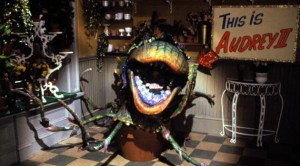 Seymour realizes that to keep feeding the plant will require him to start killing people. He hesitates, saying that no one deserves to be murdered…but then he thinks of Orin Scrivello, Audrey’s abusive boyfriend. Scrivello is a sadistic dentist, who enjoys getting high on laughing gas and torturing his patients (and who is played to the hilt by Steve Martin). Seymour heads to the dentist’s office, intent on doing him in. However, before Seymour can commit to the dark deed, Orin’s laughing gas apparatus malfunctions, delivering an overdose and killing him. Relieved, Seymour carts the dentist’s body home and feeds it, piecemeal, to the plant.
Seymour realizes that to keep feeding the plant will require him to start killing people. He hesitates, saying that no one deserves to be murdered…but then he thinks of Orin Scrivello, Audrey’s abusive boyfriend. Scrivello is a sadistic dentist, who enjoys getting high on laughing gas and torturing his patients (and who is played to the hilt by Steve Martin). Seymour heads to the dentist’s office, intent on doing him in. However, before Seymour can commit to the dark deed, Orin’s laughing gas apparatus malfunctions, delivering an overdose and killing him. Relieved, Seymour carts the dentist’s body home and feeds it, piecemeal, to the plant.
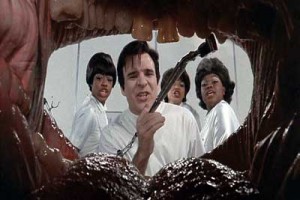
“I am your dentist, and I enjoy the career that I picked / I am your dentist, and I get off on the pain I inflict.”
With a supply of fresh meat, Audrey II blooms exponentially once more, triggering a similarly meteoric growth in Seymour’s renown. He begins receiving offers to endorse fertilizers and host gardening programs. Meanwhile, with that pesky boyfriend out of the way, the real Audrey also turns her attentions to Seymour. But Seymour is caught in a pickle: All his dreams are coming true…but only as long as he continues his string of covert homicides.
Here, the plots of the musical and film diverge significantly. In the musical, after devouring Seymour’s suspicious boss, the plant hypnotizes Audrey and begins eating her as well. Arriving at the scene, Seymour quickly pries Audrey from the jaws of the plant, but it is too late. Audrey assures Seymour that she will “probably die very shortly,” and implores him to feed her to the plant, so that his fame and success will continue to grow. Horrified, Seymour reluctantly does so.
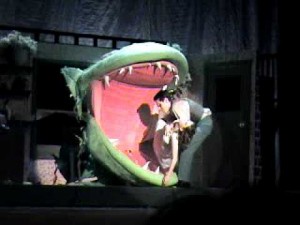 Almost immediately, Seymour is approached with still more prestigious offers: The editor of “Life” magazine even offers to put him on the cover. Additionally, a man suggests that by taking a graft of the Audrey II, it would be possible to cultivate other examples of the species…until little “Audreys” reside in every household in America. Realizing that this world conquest was the plant’s intention all along, Seymour returns to the shop and attempts to hack the plant apart. But Audrey II has grown too large and powerful, and devours Seymour. Later that evening, the entrepreneur sneaks into the florist and takes a graft from the plant himself, disappearing into the night. An epilogue informs us that, “subsequent to the events you have just witnessed, in cities across America, events which bore a striking resemblance to the ones you have just seen began occurring.” Audrey II and its progeny overpower the Earth, all by continuing the ploy of promising people their wildest dreams in exchange for fresh meat. The plants “eat New York, and Peoria, and this theater,” and the show’s Greek chorus warns us, “whatever they offer you, don’t feed the plants.”
Almost immediately, Seymour is approached with still more prestigious offers: The editor of “Life” magazine even offers to put him on the cover. Additionally, a man suggests that by taking a graft of the Audrey II, it would be possible to cultivate other examples of the species…until little “Audreys” reside in every household in America. Realizing that this world conquest was the plant’s intention all along, Seymour returns to the shop and attempts to hack the plant apart. But Audrey II has grown too large and powerful, and devours Seymour. Later that evening, the entrepreneur sneaks into the florist and takes a graft from the plant himself, disappearing into the night. An epilogue informs us that, “subsequent to the events you have just witnessed, in cities across America, events which bore a striking resemblance to the ones you have just seen began occurring.” Audrey II and its progeny overpower the Earth, all by continuing the ploy of promising people their wildest dreams in exchange for fresh meat. The plants “eat New York, and Peoria, and this theater,” and the show’s Greek chorus warns us, “whatever they offer you, don’t feed the plants.”
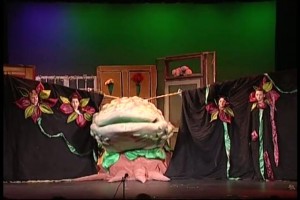
The plant’s victims blossom forth from the main pod, and proceed to sing about the dangers of giving in to greed.
In the film, however, Seymour catches on to the plant’s intentions before it can eat Audrey, and he confronts the flytrap in a final showdown. While Audrey II sings “Mean Green Mother From Outer Space,” a film-exclusive number in which the plant confirms its extra-terrestrial origins, Seymour successfully manages to electrocute the plant, bringing the shop down on them both. Seymour emerges from the rubble, and he and Audrey move to a suburb, where they buy the perfect little picket-fenced tract house of Audrey’s dreams. Everything is hunky-dory…save for the strangely familiar seedling blooming on their front lawn.
 The original cut of the film had the same ending as the musical, including a nearly 15-minute sequence in which giant Audrey II specimens terrorize various cities around the globe, with the final shot showing several of the plants creeping up the side of the Statue of Liberty and destroying it. Frank Oz was obliged to replace this sequence with a “happy ending” when the original was deemed too bleak in test screenings.
The original cut of the film had the same ending as the musical, including a nearly 15-minute sequence in which giant Audrey II specimens terrorize various cities around the globe, with the final shot showing several of the plants creeping up the side of the Statue of Liberty and destroying it. Frank Oz was obliged to replace this sequence with a “happy ending” when the original was deemed too bleak in test screenings.
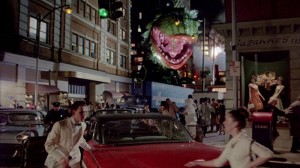 After much consideration, I think I prefer the stage ending. While the bleak ending doesn’t seem to give the human Audrey as much agency (being hypnotized and then resigning herself to death after only being briefly gummed by the plant), it provides much better closure on the story arc. Little Shop of Horrors is essentially a retelling of the Faust story: A man tinkers with supernatural forces which promise to grant his every wish, in exchange for him handing over his soul. While the previously mundane and inept Seymour gains fame and love, he loses his ability to appreciate them due to his guilty conscience. Ultimately, however, he opts to continue doing dastardly deeds to hide his crimes and increase his popularity. Thus, this arc is only truly completed if Seymour gets some kind of comeuppance. So, much as I’d hate to see Rick Moranis mutilated, the story really seems to call for it, and axing the original ending in favor of a more “Hollywood” alternative leaves the movie feeling unresolved.
After much consideration, I think I prefer the stage ending. While the bleak ending doesn’t seem to give the human Audrey as much agency (being hypnotized and then resigning herself to death after only being briefly gummed by the plant), it provides much better closure on the story arc. Little Shop of Horrors is essentially a retelling of the Faust story: A man tinkers with supernatural forces which promise to grant his every wish, in exchange for him handing over his soul. While the previously mundane and inept Seymour gains fame and love, he loses his ability to appreciate them due to his guilty conscience. Ultimately, however, he opts to continue doing dastardly deeds to hide his crimes and increase his popularity. Thus, this arc is only truly completed if Seymour gets some kind of comeuppance. So, much as I’d hate to see Rick Moranis mutilated, the story really seems to call for it, and axing the original ending in favor of a more “Hollywood” alternative leaves the movie feeling unresolved.
Nevertheless, the film has a lot going for it. The music, by Howard Ashman and Alan Menken (perhaps better known for their work on The Little Mermaid, Beauty and the Beast, and Aladdin), is on par with any of those Disney classics. Audrey II is portrayed with the incredible puppetry to be expected from Muppeteer Frank Oz, which is showcased particularly adeptly in the “Mean Green Mother” number. Finally, the actors are all wonderful in their roles, particularly the manic Martin as Orin and Bill Murray as the masochistic patient who foils the dentist’s sadistic aims (the role originally played by Jack Nicholson in the 1960 film).
 -Tidbit: Musical elements of the Little Shop score are recognizably re-used in several later Ashman/Menken collaborations. For example, in the song “Somewhere That’s Green,” the final line is very similar in melody and meter to the final line of “Part of Your World” from The Little Mermaid:
-Tidbit: Musical elements of the Little Shop score are recognizably re-used in several later Ashman/Menken collaborations. For example, in the song “Somewhere That’s Green,” the final line is very similar in melody and meter to the final line of “Part of Your World” from The Little Mermaid:
“Someday I know / we two will go / somewhere that’s green”
“Out of the sea / wish I could be / part of that world”
-Additionally, the film features a “Greek chorus” composed of sassy black women…an idiosyncratic pairing which would be re-used in Disney’s Hercules…for which Alan Menken also wrote the music.
—
Brian Terrill is the host of television show Count Gauntly’s Horrors from the Public Domain. You can keep up with Brian’s 100 Film Favorites countdown here.


